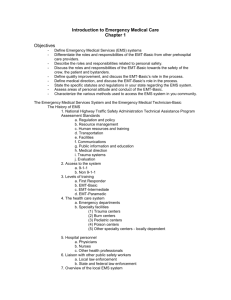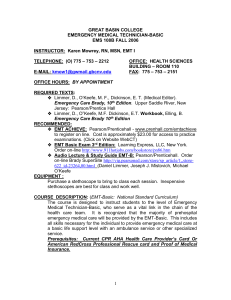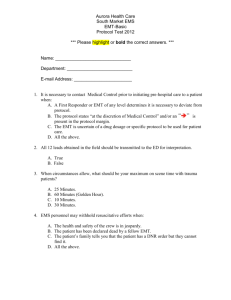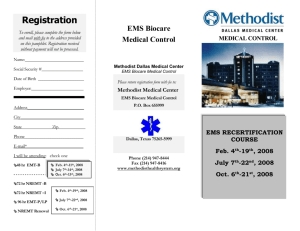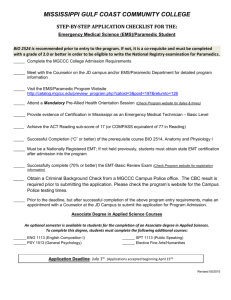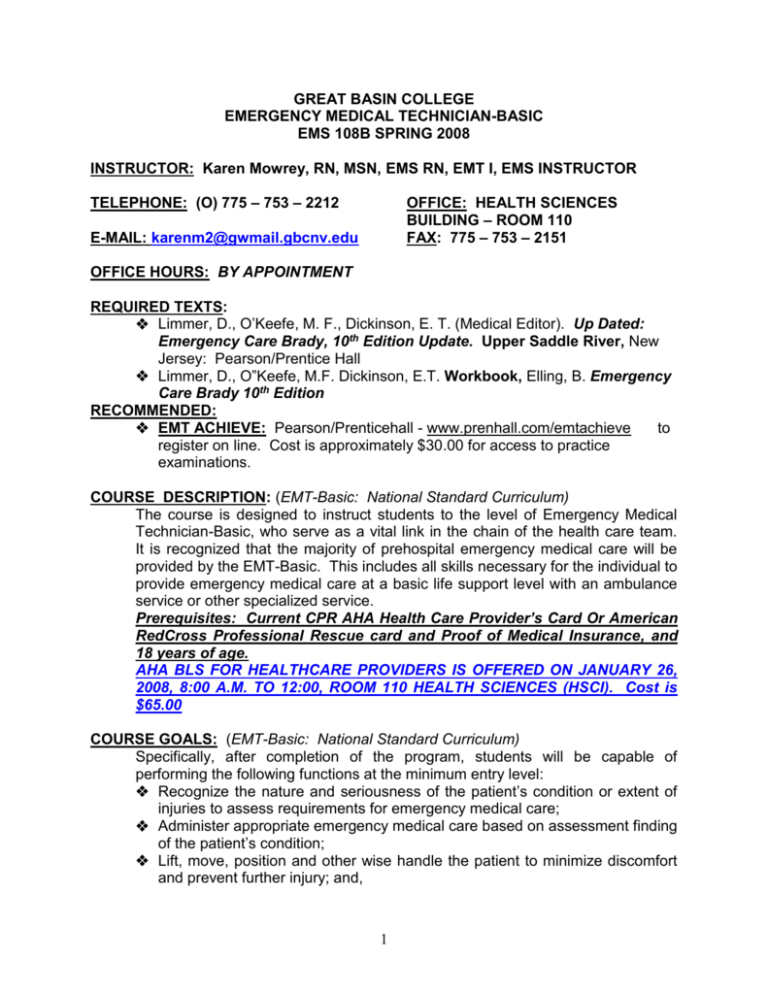
GREAT BASIN COLLEGE
EMERGENCY MEDICAL TECHNICIAN-BASIC
EMS 108B SPRING 2008
INSTRUCTOR: Karen Mowrey, RN, MSN, EMS RN, EMT I, EMS INSTRUCTOR
TELEPHONE: (O) 775 – 753 – 2212
OFFICE: HEALTH SCIENCES
BUILDING – ROOM 110
FAX: 775 – 753 – 2151
E-MAIL: karenm2@gwmail.gbcnv.edu
OFFICE HOURS: BY APPOINTMENT
REQUIRED TEXTS:
Limmer, D., O’Keefe, M. F., Dickinson, E. T. (Medical Editor). Up Dated:
Emergency Care Brady, 10th Edition Update. Upper Saddle River, New
Jersey: Pearson/Prentice Hall
Limmer, D., O”Keefe, M.F. Dickinson, E.T. Workbook, Elling, B. Emergency
Care Brady 10th Edition
RECOMMENDED:
EMT ACHIEVE: Pearson/Prenticehall - www.prenhall.com/emtachieve
to
register on line. Cost is approximately $30.00 for access to practice
examinations.
COURSE DESCRIPTION: (EMT-Basic: National Standard Curriculum)
The course is designed to instruct students to the level of Emergency Medical
Technician-Basic, who serve as a vital link in the chain of the health care team.
It is recognized that the majority of prehospital emergency medical care will be
provided by the EMT-Basic. This includes all skills necessary for the individual to
provide emergency medical care at a basic life support level with an ambulance
service or other specialized service.
Prerequisites: Current CPR AHA Health Care Provider’s Card Or American
RedCross Professional Rescue card and Proof of Medical Insurance, and
18 years of age.
AHA BLS FOR HEALTHCARE PROVIDERS IS OFFERED ON JANUARY 26,
2008, 8:00 A.M. TO 12:00, ROOM 110 HEALTH SCIENCES (HSCI). Cost is
$65.00
COURSE GOALS: (EMT-Basic: National Standard Curriculum)
Specifically, after completion of the program, students will be capable of
performing the following functions at the minimum entry level:
Recognize the nature and seriousness of the patient’s condition or extent of
injuries to assess requirements for emergency medical care;
Administer appropriate emergency medical care based on assessment finding
of the patient’s condition;
Lift, move, position and other wise handle the patient to minimize discomfort
and prevent further injury; and,
1
Perform safely and effectively the expectations of the job description.
COURSE CONTENT: (EMT-Basic: National Standard Curriculum)
Overview of the human body
Medical-Legal Issues of EMS
Assessing Emergency Scenes and prehospital patients
EMT-Basic Pharmacology
Respiratory and Cardiac Emergencies
Drug and Alcohol-related crisis
Environmental and Behavioral Emergencies
Trauma Emergencies
Emergency Childbirth and Pediatric Emergencies
Functioning in the Prehospital Care Environment
LEARNING OUTCOMES:
Upon completion of the course, the student will demonstrate the ability to:
Comprehend, apply and evaluate the clinical information relative to his/her
role as an entry level EMT-Basic
Demonstrate the technical proficiency in all skills necessary to fulfill the role of
an entry=level EMT-Basic
Able to follow protocols consistent with the National Standard Curriculum.
ATTENDANCE AND PARTICIPATION:
Attendance and participation to all classes and laboratory practice is required.
Unavoidable absences: Contact the instructor
The Department of Transportation curriculum states students may not
miss more than 16 hours of the course or they will not be eligible for
NAEMT certification (NO EXCEPTIONS).
All missed hours must have make-up work completed and turned in one
week after the absence. (This is a D.O.T. requirement and is
kept
on file) SPECIAL CONSIDERATIONS:
Students will be required to perform assessments and skills on each other and act as
patients themselves. Proper attire must be worn in order to safely and properly perform
theses required tasks. Skirts, dresses, low cut shirts, “short” shorts, and sandals are
not appropriate for activities required. Low cut jeans and pants must have a
shirt/blouse that is long enough to cover sufficiently during lifting and bending activities.
TOUCHING:
DUE TO THE NATURE OF THIS CLASS STUDENTS ARE REQUIRED TO TOUCH
EACH OTHER DURING ASSESSMENTS AND SKILLS. ANY INAPPROPRIATE
TOUCHING OR SEXUAL COMMENTS WILL RESULT IN IMMEDIATE DISMISSAL
FROM THE CLASS.
EMERGENCY DEPARTMENT CLINICAL EXPERIENCE:
2
Wear a white or light colored shirt (button down or polo-type – No emblems), dark
colored pants, CLEAN athletic shoes or dark leather shoes (no cowboy boots), hear
clean and pulled away from face, facial hair neatly trimmed , no dangly earrings, and
NO “facial or mouth” jewelry allowed. Clothing must be neat and clean. No sweat pants
or shorts.
DO NOT WEAR SCRUBS! Fingernails clean, and moderate length, light make-up and
mild scents only. No gum chewing or food in the clinical area. Good personal hygiene
with absence of mouth and body odor.
OPTIONAL AMBULANCE RIDE ALONG:
Applications will be available to apply for a temporary student license for the duration of
the EMT – B Course.
CLINICAL/FIELD ROTATIONS:
You must bring the following with you to each clinical/field site:
Great Basin College ID badge (photos will be taken in class)
A watch with a second hand, stethoscope, pater and pen
Evaluation form
Appropriate dress
IMMUNIZATIONS:
Copies of your immunization records are due at the beginning of class on
February 13, 2008
Emergency Department Clinical Rotation Requirements include:
1. Negative T.B. skin test or chest x-ray within the last 12 months;
2. * Current MMR (measles,mumps, rubella), or MMR Booster or appropriate titer
levels;
3. Tetanus immunization with the last 10 years;
4. Hepatitis B series (2 required by first day of class (1/23/2008)
5. If you were born before 1957, you are exempt from the MMR requirement.
Note: Immunizations are available at Nevada Health Centers at the old Elko Clinic
building. Call 738-5850 for an appointment, or contact your health care provider
To be eligible for National Registry of EMTs (NREMT) testing you must
complete the 10 hour Emergency Room clinical rotation. Proof of
immunization is required for the Emergency Room rotation.
ACADEMIC INTEGRITY:
Great Basin College considers academic integrity one of it highest values. A student
how obtains academic credit for work that is not the product of his or her own effort is
3
being dishonest and undermine the academic integrity of the college. Violations of
academic integrity include, but are not limited to, one or more of the following acts:
Cheating (giving or receiving information related to examination
questions)
Plagiarism
WebCampus Examinations:
Students are not allowed to print or copy any test or any part of a test.
This is considered a form of cheating and appropriate action will be taken.
Such behaviors are also in violation of Great Basin College Student Conduct
Code.
EDUCATION AND CERTIFICATION:
The education component is designed to facilitate the acquisition of cognitive
knowledge and psychomotor skills necessary to obtain a certification to practice as an
EMT-B. Although the educational component is closely associated with the entities that
certify and license EMS providers, the two processes are separate and distinct.
Successful completion of the education component does not ensure certification or
licensure.
CIVILITY STATEMENT FOR THE CLASSROOM:
For the learning experience, mutual respect is required by the student and the
instructor. Neither the student or the instructor, should be subject to behavior that is
rude, disruptive, intimidating, or demeaning. The instructor has the primary
responsibility for and control over classroom behavior and maintenance of academic
integrity.
METHOD OF EVALUATION:
Seven (7) Module Tests (WebCT)
Final Test
Work Book (36 Chapters 5 pts each)
Home Work Assignment: Geriatric
Patients (Due March 3, 2008)
Home Work Assignment: EMS
Response to Terrorism (Due April 7,2008)
Final Skills Application Scenarios (5)
Practical Skills Competencies
POINTS POSSIBLE
= 700 points
= 100 points
= 180 points
TOTAL Points Possible
= 1,000 points
= 10 points
= 10 points
= Pass/Fail
= Pass/Fail
Students have 70% cumulative average per DOT regulation and meet attendance
requirements to be eligible to take the NREMT examination.
GRADING SCALE:
Course grade will be based on a percentage of total possible points according to the
following scale:
4
100
93
89
86
83
-
94
90
87
84
80
=
=
=
=
=
A
A
B+
B
B-
79
76
75
-
77
-
70
= C+
= C
= C-
STUDENTS MUST HAVE AT LEAST A 70% CUMULATIVE AVERAGE & MEET THE
ATTENDANCE REQUIREMENT TO BE ELIGIBLE TO TAKE THE NATIONAL
REGISTRY EXAMINATION. Example: The student who has 70% but has missed
more 16 hours of class would not be eligible for NAEMT testing.
MEDICAL DIRECTOR:
Our course medical director is Jill Oswalt, M.D., an Emergency Physician at
Northeastern Nevada Regional Hospital. Dr. Oswalt approves the curriculum and acts
as the ultimate medical authority regarding course content, procedures, protocols, and
acts a liaison with the medical community. Dr. Oswalt or her designee is responsible to
verify student competencies in the cognitive, affective and psychomotor domains.
ACCOMODATIONS FOR DISABILITIES:
GBC supports providing equal access for students with disabilities. An advisor is
available to discuss appropriate accommodations with students. Please contact the
ADA Officer (Julie Byrnes) in Elko at 775.753.2271 at your earliest convenience to
request timely and appropriate accommodation.
SCHEDULE FOR WebCampus TESTING
MODULE I: Preparatory (Module I and IA)
Test period begins February 7 at 0600 and ends February 11 at 2330
**Note: This test is in two (2) parts. 75 minutes is allowed for each part
MODULE II: Airway Management
Test period begins February 14 at 0600 and ends February 17` at 2330
MODULE III: Patient Assessment
Test period begins March 6 at 0600 and ends March 9 at 2330
MODULE IV: Medical Emergencies
Test period begins April 3 at 0600 and ends April 6 at 2330
MODULE V: Trauma
Test period begins April 24 at 0600 and ends April 27 at 2330
MODULE: INFANTS & CHILDREN VI AND OPERATIONS VII
Test period begins May 1 at 0600 and ends May 4 at 2330
FINAL TEST:
Test period begins May 1 at 0600 and ends May 7 at 2330
WebCampus INFORMATION
Students will be given designated timeframes (see above) of four days (Thursday
through Sunday to complete WebCampus module evaluations. Please note that the
time frame was extended to Monday 2330 for Module I because it consists of two parts.
5
Each evaluation module has 50 multiple choice questions worth 50 points. One hour
and 15 minutes is allowed for each module.
Once the test is started, students must finish their test within the 1 hour
15 minute time frame.
WebCampus will not allow you to start a test and go back and
finish it later.
Printing or copying any test or part of test is cheating and action
will be taken accordingly. (See Academic Integrity statement )
COMPUTER ACCESS ON THE GBC CAMPUS: HIGH TECH CENTER
HOURS OF OPERATION
Monday – Friday 0800 – 2200
Saturday 0800 - 1730
SCHEDULE FOR SATURDAY CLASSES AND NREMT SKILLS TESTING
04/24/08
Saturday Class 0900 – 1500
State EMS final Skills Testing – TO BE ANNOUNCED
COURSE COMPLETION PAPERWORK
Upon successful completion of the course students will complete the following:
1. EMS Course Completion Form. It is signed by the Medical Director
and Course Coordinator.
2. A copy of a valid ID
3. A copy of your CPR card front and back
4. The Course Evaluation Form (complete in class)
5. The National Registry exam fee will be $70.00 due upon registration for
the exam. NREMT registration and examination information will be available
prior to completion of the program.
6. NREMT examinations are available at GBC by appointment . Information will be
provided upon course completion.
Revised: 01/11/2008
MEMORANDUM OF UNDERSTANDING
THIS DOCUMENT MUST BE TURNED IN BY THE SECOND CLASS
PERIOD on 1/28/08
I, __________________________________, acknowledge receipt of a
(Print Name)
6
course syllabus and course outline. I understand I have enrolled in a
class that requires higher grading standards and attendance
requirements than other Great Basin College courses. I will do my best
to maintain the higher standards in accordance with the D.O.T.
National Standard Curriculum for the EMT –Basic. I have had an
opportunity to ask questions and clarify the course requirements. I
agree to follow these standards and expectations which include ethical
and behavioral standards.
Signed: _____________________________________ Date: ___________
Address: ____________________________________________________
Telephone Number: ____________________E-Mail: ________________
7

